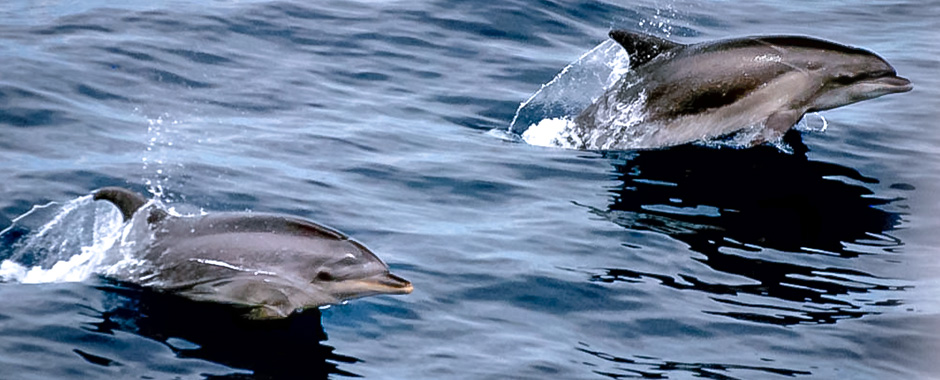Distribution
Bottlenose dolphins live in temperate and tropical waters worldwide. Distribution is generally limited to surface water temperatures of 10° to 32°C (50° to 90° F).
In the Pacific Ocean, bottlenose dolphins are found from northern Japan to Australia and from Southern California to Chile. They are also found offshore in the eastern tropical Pacific as far west as the Hawaiian Islands. Off the California coast bottlenose dolphins have been observed as far north as Monterey, particularly during years of unusual warmth.
In the Atlantic Ocean, bottlenose dolphins are found from Nova Scotia to Patagonia and from Norway to the tip of South Africa. They are the most abundant dolphin species along the United States' coast from Cape Cod through the Gulf of Mexico.
Bottlenose dolphins are also found in the Mediterranean and Black Seas.
Indo-Pacific bottlenose dolphins are found in the Indian Ocean from Indonesia to Australia to South Africa, the Red Sea, and in the tropical and subtropical waters of the western Pacific.

Known range of bottlenose dolphins are indicated in dark blue.
Habitat
Bottlenose dolphins inhabit warm temperate waters, adapting to several marine and estuarine habitats, including, occasionally, rivers. Habitat use is influenced by environmental heterogeneity; meaning these animals distribute through an ecosystem depending on factors like resources, depth, water temperature, sea-bed gradient and type of sediment.
Scientists theorize that differing ecological characteristics throughout their range have led to differences between bottlenose dolphin populations. Because bottlenose dolphin populations have inshore and offshore distributions, scientists identify two ecotypes with anatomical, physiological, behavioral, ecological and genetic differences. For example, bottlenose dolphins in Scotland favor deeper areas than those from Florida, U.S., that prefer shallow waters of less than 3 m (9.8 ft.) depth.
- Coastal dolphins generally form smaller cohesive groups (<20) than the offshore (>100).
- Inshore bottlenose dolphins are typically seen in bays, tidal creeks, inlets, marshes, rivers, and waters along the open ocean beach, often at depths of 3 m (9.8 ft.) or less. Some inshore ecotypes seem to be adapted for warm, shallow waters. Its smaller body and larger flippers suggest increased maneuverability and heat dissipation.
- The distribution/migration of prey correlated with seasonal changes in water temperature may account for the seasonal movements of some dolphins. Inshore bottlenose dolphins found in warmer waters show less extensive localized, seasonal movements and many have been observed staying within a limited, long-term home range, such as in Sarasota Bay, Florida. Adult males range more widely than females, often encompassing the ranges of several female bands. Dolphin communities may overlap providing for genetic exchange. These neighboring communities may be distinct in both behavior and genetics.
- In the Northwest Atlantic, researchers determined that bottlenose dolphins within 7.5 km (4.65 mi.) from shore were coastal ecotypes. Dolphins beyond 34 km (21mi.) from shore were offshore ecotypes. They also observed that the two ecotypes overlap between those boundaries, and concluded that further habitat-use analysis must be done to explain that situation.
- In the Gulf of California, coastal and offshore ecotypes differ in color, morphology, and group size. The coastal form is bigger, more robust, and with a lighter dorsal color than the offshore type. Its rostrum and pectoral flippers are shorter and groups are formed by <20 individuals. In this study, it was also seen that offshore bottlenose dolphins associate with sperm whales and have a similar trophic position with them (specifically females and juveniles). Dolphins benefit from this interaction by feeding on similar prey.



Migration
Variations in water temperature, movements of food fish, and feeding habits may account for the seasonal movements of some dolphins to and from certain areas.
Some coastal dolphins in higher latitudes show a clear tendency toward seasonal migrations, traveling farther south in the winter. For example, coastal bottlenose dolphins on the Atlantic side of the U.S. migrate seasonally between New Jersey and North Carolina.
Coastal dolphins in warmer waters show less extensive, localized seasonal movements.
Some coastal animals stay within a limited home range: an area in which individuals or groups regularly move about during day-to-day activities.
- Individual dolphins that live within a home range are called "local residents". Resident dolphins have been identified along the coasts of Georgia, Florida, Texas, southern California, Gulf of California, and South Africa.
- Groups of dolphins that reside within a home range make up "resident communities". The Sarasota, Florida resident dolphin community home range is an area of about 125 km2 (48.3 mi2). Home ranges may overlap.
Population
Bottlenose dolphins are not endangered or threatened.
The worldwide population of common bottlenose dolphins is about 600,000.
Indo-Pacific bottlenose dolphins are abundant, but the overall population is unknown.
Chromosome banding techniques have proven useful in bottlenose dolphin population studies. In some areas, scientists can identify individuals and determine relationships among dolphins in a group.




